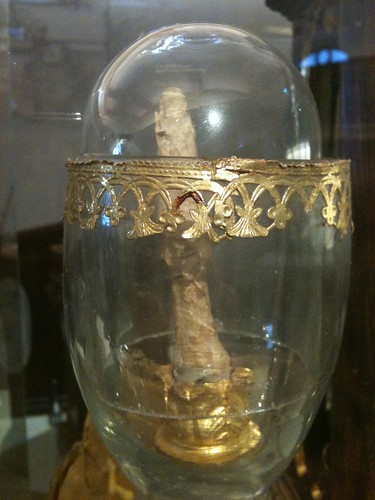This museum is a bit different from our usual science museums. The Galileo Museum of the History of Science was based on the Medici and Lorraine collections of science artifacts and memorabilia (from when they were major players in Florence). So it is a much more traditional museum, with lots of things to look at, and very little to touch or interact with. But we loved it anyway. Much of the memorabilia is associated with Galileo, or his discoveries, and many of the other exhibits are originals of the kind of explanatory exhibits we’ve seen in many other museums.
You can see the start of science education, right here. So, that said, I’m going to use our standard criteria to judge it, to see how we end up.
1. The Museum must engage and excite – I usually use this category to judge interactivity. But in this case, the excitement was in the historic nature of the exhibits. We were all excited to see Galileo’s actual finger (it was like a shrine to science, rather than the usual religious ones we’ve been seeing). But the lack of interactivity to wear us down after a while, so I can’t rate this too highly. 7/10
2. The exhibits must work and not baffle – There were very few working exhibits. But every now and again there was a television display of some aspect of science associated with the exhibits. Callum was fascinated by one which explained in great detail how they used to make globes of the world. Even though it was in Italian, with English subtitles, he spent the next 10 minutes reexplaining it to all of us. 9/10.
3. A play area should not substitute for teaching science in the museum. This is a simple one. There wasn’t a play area. Not sure if that gives it good or low marks! I’ll go with a medium level 8/10.
4. Televisions and computers are no longer, in themselves, cool, or more generally, everything should be up to date. The video displays were excellent, and used technology as an explanation, rather than for its own sake. But the very static museum nature of this museum tends against a perfect score here 8/10.

5. Museums should tell a story. This museum was surprisingly good at telling a story. The story was partly about the discovery of much of early science – from Galileo’s early discoveries about motion and pendulums, to the explorations of the world, to the early days of science education. That was a story I didn’t know, and it was fascinating to see models of exhibits that had been used by Humphrey Davy and Faraday to explain science to lay people, and are still the same exhibits in many science museums today 9/10.
Overall, 41/50, but with a strong caveat that very little interactivity makes it harder work for a parent.
Practicalities: There was no cafe. There was a souvenir shop, but nothing particularly grabbed us. The total cost of the museum was 20 Euros for a family of four, which is pretty good, particularly in expensive Florence. And the museum is right next door to the Uffizi galleries, which makes a good contrast on a day out in Florence with kids.
Read Evan’s geekdad review here.